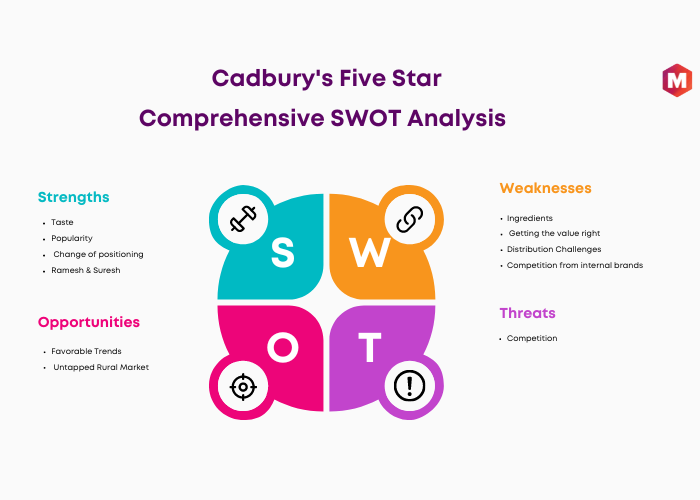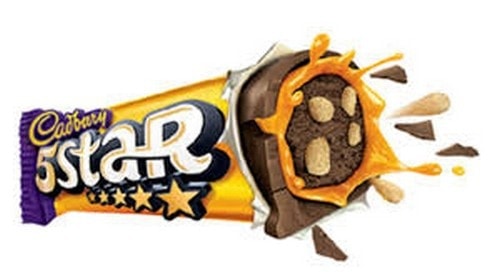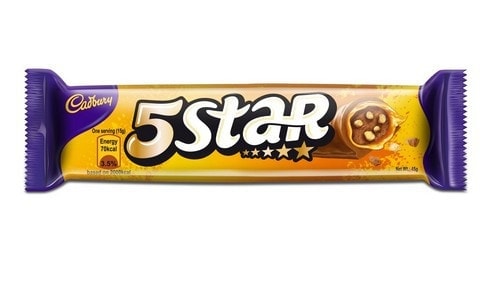Let’s explore the SWOT analysis of Cadbury’s Five Star by understanding its strengths, weaknesses, opportunities, and threats.
One of India’s oldest chocolate bars in its category, Cadbury’s 5 Star, was launched in 1953 and, since then, has been one of the trendiest chocolates in the region. Cadbury’s 5 Star, which Kraft Foods owned, is now officially a part of the product portfolio of Modelez International.
The brand is available in many popular variants, like Cadbury’s 5 Star, Cadbury’s 5 Star Caramel, Cadbury’s 5 Star 3 D, Cadbury’s 5 Star Treats, etc. The brand, which has always stayed on trend, is also a popular snack among kids due to its rich taste and texture and the presence of nuts and caramel. Cadbury’s 5 Star has also been famous for some fascinating advertisements that have captured the mindshare of Indian customers.
Overview of Cadbury’s Five-Star:
- Product type: Chocolate bar
- Owner: Cadbury Lacta (Brazil market)
- Country: India (first introduction), United Kingdom (owner origin)
- Introduced: 1969, 55 years agoMarkets: Brazil, India, Indonesia, Malaysia, Philippines, and South Africa
Table of Contents
SWOT Analysis of Cadbury’s Five-Star
Strengths of Cadbury’s Five-Star
1. Taste
Cadbury’s 5 Star is known for its taste difference from other fillings. As the positioning claims of the brand indicate, the chocolate is chewy and rich in various fillings like Noga, caramel, and almonds. Peanuts, raisins, and nuts. This makes it popular as a chocolate and a snack for kids and adults alike.
2. Popularity
Cadbury’s 5 Star is the market leader in India’s count line segment of plates, with a market share of around 67 %. The brand has retained its success for almost four decades and is also sold in markets like Brazil, the Philippines, Malaysia, and South Africa, where it is gaining popularity.
3. Change of Positioning
Cadbury has always stayed in trend primarily because it could alter its positioning concerning the trend in vogue. During the early years of its launch, Cadbury 5Star was positioned to indicate togetherness, hunger, energy, irresistible and soft chew.
However, as people got used to this over time and competitors started introducing brands with similar attributes, Cadbury 5-Star started pitching in terms of being ‘Lost in Taste”. This is a very apt positioning for people who look up to chocolate as a luxury that helps them stay afloat amidst stressful lives.
4. Ramesh & Suresh
In a master move, Cadbury’s 5 Star introduced two quirky characters into the advertisements, Ramesh & Suresh, who have been the brand icons for the chocolate for quite some time. These characters and humorous situations they associate themselves with have increased the brand recall of Cadbury’s 5-Star Manifold.
Weaknesses of Cadbury’s Five-Star
1. Ingredients
Though the pack indicates vegetable oil, fats, and artificial flavors, there is no mention of what each specific content has. This creates a lot of doubts in the customer’s mind about the exact composition of the chocolate.
2. Getting the value right
The commodity prices are on the rise not just in India but globally. Chocolate brands like Cadbury’s 5 Star, known for their rich taste, struggle to value their products while managing price fluctuations.
3. Distribution Challenges
One allegation leveled again, not just Cadbury’s 5 Star but other brands of milk company, is that they melt. In higher-temperature regions and during summer, chocolate manufacturers face many challenges in preventing or controlling the melting of chocolates during distribution.
4. Competition from internal brands
In India’s 8000 crore chocolate market, Cadbury’s 5 Star faces the highest competition from an internal brand from the same company, Cadbury’s Dairy Milk, which is the market leader in the segment. The company finds it tricky to balance the budgets for promotion while ensuring that both brands get the same visibility.
Opportunities of Cadbury’s Five-Star
1. Favorable Trends
The Indian chocolate industry will benefit from favorable ecrural-to-urbanlike growth in per capita income, increased frequency of shopping, and more spendable income. The rural-to-urban migration is yet another favorable trend. All these are likely to increase the per capita consumption of chocolate.
2. Untapped Rural Market
Whilvastltinational confectioners who have tried to enter into famousrimarily look at only urban markets,. There is the huge untapped rural market,, which can be easily targeted by popular brands like Cadbury’s 5 Star.
Threats of Cadbury’s Five-Star
1. Competition
The confectionery market is extremely competitive, with several firms producing comparable items. New entrants and competing innovations have the potential to reduce Five Star’s market dominance.
Conclusion
The SWOT analysis of Cadbury’s Five Star reveals that the brand has a considerable advantage due to its distinct taste, appeal, and innovative marketing methods, particularly the memorable Ramesh & Suresh campaign. However, concerns such as ambiguity in ingredient transparency, price volatility, distribution issues, and internal competition cannot be overlooked.
The rising income and urbanization trends give exciting potential for additional market penetration, particularly in underutilized rural areas. Nonetheless, the brand must remain alert against tough competitors in the chocolate category. Cadbury’s Five Star can continue to capture chocolate lovers while maintaining market leadership through strategic emphasis and flexibility.
Liked this post? Check out the complete series on SWOT


